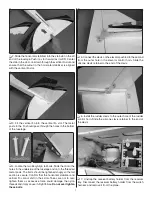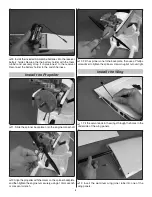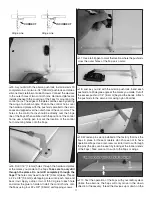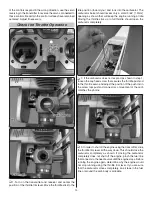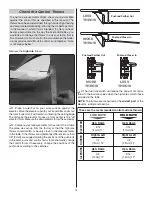
20
Flight
Once airborne, maintain a steady climb and make the initial
turn away from the runway. When at a comfortable, safe
altitude, throttle back to slow the model and raise the fl aps
(if equipped), thus giving you time to think and react. The
Avistar Elite should fl y well at half or slightly less than half
throttle. Adjust the trims so the plane fl ies straight and level.
After fl ying around for a while, and while still at a safe altitude
with plenty of fuel (or battery charge), practice slow fl ight and
execute practice landing approaches by reducing the throttle
further to see how the model handles when coming in to land.
Add power to see how the model climbs as well. Continue to
fl y around while learning how the model responds. Mind your
fuel level, but use this fi rst fl ight to become familiar with the
model before landing.
Landing
When ready to land, gently lower the fl aps (if equipped) and
pull the throttle stick fully back while fl ying downwind just
before making the 180-degree turn toward the runway. Allow
the nose of the model to pitch downward to gradually bleed
off altitude. Continue to lose altitude, but maintain airspeed
by keeping the nose down while turning. Apply up elevator
to level the plane when it reaches the end of the runway and
is about fi ve to ten feet off the ground. If the model is too far
away, carefully add a small amount of power to fl y the model
closer. If going too fast, smoothly advance the throttle and allow
the model to gain airspeed, then apply elevator to climb out
and go around to make another attempt. When fi nally ready
to touch down, continue to apply up elevator, but not so much
that the airplane will climb. Continue to apply up elevator while
the plane descends until it gently touches down.
After you have landed and shut the engine off, adjust the
pushrods on the ailerons, elevator and rudder as necessary
so the trim levers on the transmitter may be returned to center.
This will not be required on any of the controls that did not
need trim adjustments.
MAINTENANCE TIPS
Clean Up
●
After fl ying for the day, use your fuel pump to drain excess
fuel from the tank.
This model belongs to:
Name
Address
City
, State
, Zip
Phone Number
AMA Number
●
After each day's fl ying, use spray cleaner and paper towels
to thoroughly clean the model.
●
The Avistar Elite is factory-covered with iron-on model
covering fi lm. Should repairs ever be required, the covering
can be patched with new pieces of iron-on covering. Among
several types of covering that will work, Top Flite MonoKote
fi lm may be used to make repair patches to this model.
MonoKote is packaged in six-foot rolls, but some hobby
shops also sell it by the foot. If only a small piece of covering
is needed for a minor patch, perhaps a fellow modeler would
give you some. The covering is applied with a model airplane
covering iron, but in an emergency a regular iron set to a
lower temperature could be used.
●
Check all screws that hold the wings together, tail bolts,
engine bolts, wheel collars, etc.
●
Check all the high-stress areas for cracks or fatigue such
as the landing gear area, the wing mounting area, stab and
fi n mounting area.
FINAL NOTE
One fi nal note about fl ying your model. Have a goal or fl ight
plan in mind for
every
fl ight. For beginners, your fi rst few
fl ights should be you becoming familiar with the basic controls
of R/C. When the plane is fl ying toward you it is common
for beginner pilots to hesitate or turn the plane in the wrong
direction because the aileron and rudder control will act in
reverse from the pilot’s perspective as it was when fl ying away
from them. Focus on fl ying the model as if you were sitting
in the cockpit. With practice you will learn to do this without
having to think about it.
As you progress, your fl ight plans should include smooth
takeoffs and landings. Practice executing smooth landings
such that the Avistar approaches the runway in a smooth
and descending path with the correct airspeed and touches
down without bouncing. If possible at your airfi eld, perform
several “touch and go” landings until you are comfortable with
the plane’s landing characteristics.
Regardless of your objective for each fl ight, do not surprise
yourself by impulsively attempting a maneuver and suddenly
fi nding that you’ve run out of time, altitude or airspeed. Every
maneuver should be deliberate, not impulsive. For example, if
you’re going to do a loop, check your altitude, mind the wind
direction (anticipating rudder corrections that will be required
to maintain heading), remember to throttle back at the top, and
make certain you are on the desired rates (high/low rates).
A fl ight plan greatly reduces the chances of crashing your
model just because of poor planning and impulsive moves.
Remember to think.
Have a ball! But always stay in control
and fl y in a safe manner.
GOOD LUCK AND GREAT FLYING!


